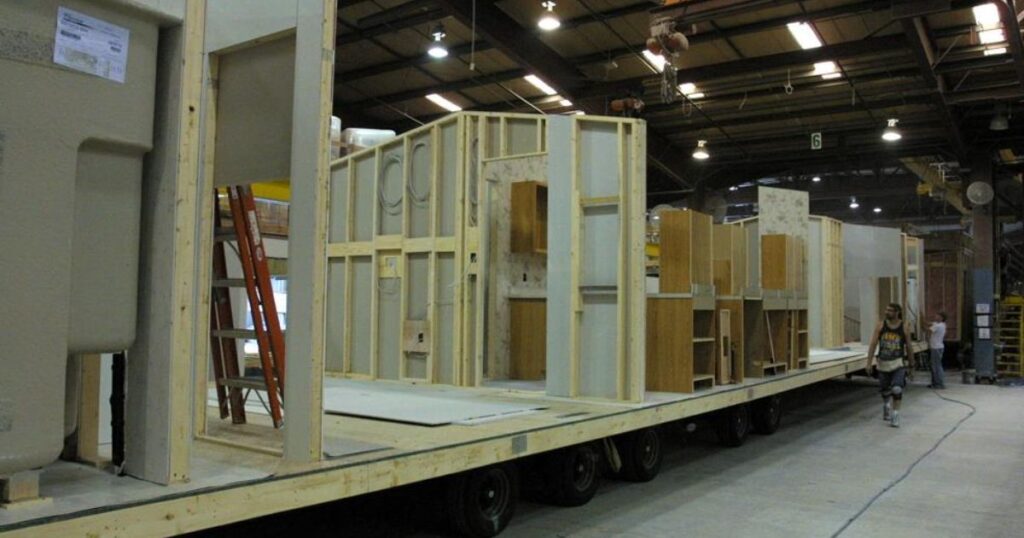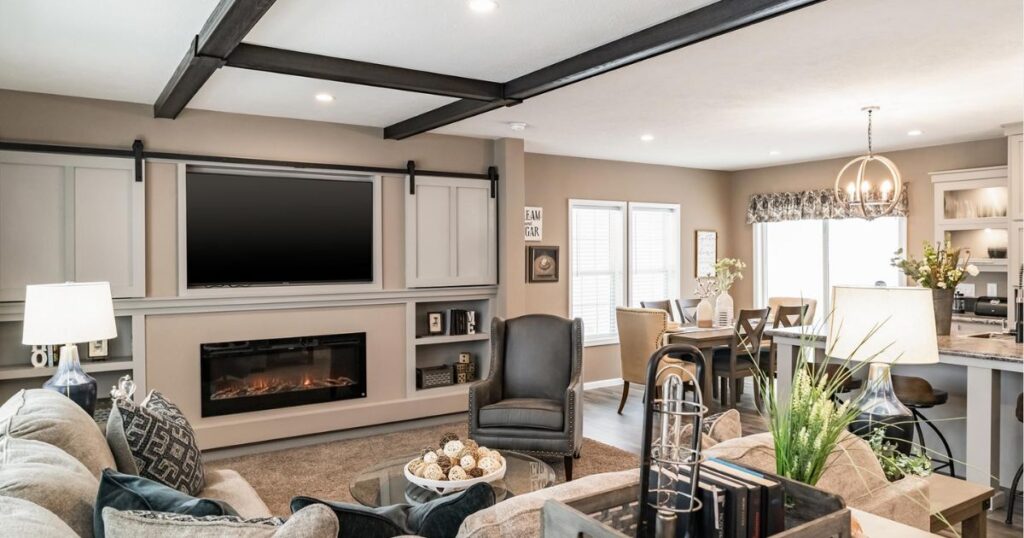Dreaming of an open-concept living space in your mobile home? Removing walls can transform that cramped, closed-off layout into a modern, airy oasis.
But before you grab that sledgehammer, there are crucial factors to consider when removing walls in a mobile home.
This comprehensive guide covers everything you need to know, from understanding load-bearing walls to executing the removal process safely and legally.
Understanding Load-Bearing Walls in Mobile Homes
In any home, load-bearing walls are the structural heroes that transfer the weight of the roof, upper floors, and even the home itself down to the foundation.
In mobile homes, these load-bearing walls are absolutely critical for maintaining the structural integrity of the unit.
One of the most important load-bearing walls in a mobile home is the marriage wall. This is a double-thick wall that runs through the center of most double-wide mobile homes, quite literally “marrying” the two sections together.
While bulky and often obstructing the floor plan, this marriage wall plays a vital role in supporting the roof.
But how can you identify load-bearing walls in your own mobile home? The exterior walls are typically load-bearing, but interior walls can be trickier to assess.
Your safest bet is to consult a structural engineer to evaluate which walls are load-bearing before any demolition occurs.
Attempting to remove a load-bearing wall improperly can potentially compromise the structural integrity of your entire home – a risk not worth taking.
Preparing for Wall Removal in Your Mobile Home

Read this Article: RENT TO OWN MOBILE HOMES
Once you’ve identified which walls are candidates for removal (hopefully with the help of a professional), it’s time to prepare for the renovation process properly. Here are some key steps:
- Obtain Necessary Permits: Most areas require permits for structural changes like wall removal, even in mobile homes. Check with your local authorities to ensure you have the proper permits before starting any work.
- Hire a Structural Engineer: While you may be able to DIY the removal of certain non-load bearing walls, any intervention with load-bearing walls should be planned and overseen by a qualified structural engineer experienced with mobile home construction.
- Gather Tools and Safety Equipment: Demolition work requires the right tools like pry bars, sledgehammers, and saws. You’ll also need proper safety gear like hard hats, eye protection, and dust masks.
- Plan for Living Accommodations: Depending on the extent of the work, you may need to make arrangements for alternative living situations during the loud, dusty demolition and reconstruction phases.
Crucial Steps Before Demolition
Even before the first swing of the sledgehammer, there are vital preparatory steps to take:
- Locate All Utilities: Carefully locate any electrical wiring, plumbing pipes, HVAC ducts, etc. running through the walls to be removed. These will need to be properly disconnected and re-routed.
- Disconnect and Re-route Utilities: With the help of licensed professionals, disconnect and temporarily re-route any utilities coursing through the walls. This may involve turning off main lines and capping off pipes/wires.
- Brace Ceiling and Roof: Once load-bearing walls are removed, the ceiling and roof will need temporary support. This often involves installing temporary vertical support posts and horizontal beams before demolition.
The Wall Removal Process Step-by-Step
Once all the preparation is complete, the wall removal can commence. Here’s a general overview of the process:
- Install Temporary Support: Per the structural engineer’s plans, install any required temporary vertical support posts and horizontal beams to support the areas where load-bearing walls will be removed.
- Demolish Non-Load Bearing Walls: Using proper tools and safety precautions, you can begin demolishing any non-load bearing wall sections marked for removal. Check for any hidden utilities one last time before demolition.
- Reinforce for Load-Bearing Wall Removal: To remove load-bearing walls safely, you’ll need to install permanent support posts, beams, and potentially re-route ductwork per the engineer’s specifications.
- Complete Wall Removal and Refinishing: With the new supports in place, remove any remaining wall sections. Then refinish the floors, ceilings, walls, etc. as needed to complete the open concept look.
Wall Removal Costs to Consider
Removing walls in a mobile home is no small undertaking, and the costs can add up quickly:
- Engineer/Architect Fees: Expect to pay $300-$1000+ for structural assessment and plans
- Permitting Costs: Permit fees can range from $100-$500 depending on your area
- Materials: Beams, posts, drywall, flooring, etc. – $1000-$5000+
- Labor Costs: If hiring contractors, this could be $5000-$15,000+
- Utility Line Re-Routing: $500-$2000 for electricians, plumbers as needed
Of course, costs can vary significantly based on the scope of work, your location, and whether you DIY some of the labor. But in general, you should budget at least $5,000-$10,000 for even a modest wall removal project in a mobile home.
Alternative Options to a Full Wall Removal
If a full wall removal seems too costly or invasive, there are lower-impact ways to help open up your mobile home’s floor plan:
- Pass-Throughs: Rather than remove a whole wall, cut open a pass-through window/archway
- Pocket Doors or Barn Doors: Replace standard doors with sliding/barn doors that don’t need clearance space
- Partial Wall Removal: Remove just a section of a non-load bearing wall
- Open Shelving: Use open shelving units rather than closed cabinets to create an airy feel
Mobile Home Wall Removal – Pros and Cons

Like any major home renovation, removing walls in your mobile home has both advantages and disadvantages to consider:
Pros:
- Open, modern floorplan feel
- Increased natural light flow
- Improved functionality and flow
- Can potentially increase home’s value
Cons:
- Significant construction costs
- Permitting and regulation hassles
- Potential structural issues if not done properly
- Dust and disruption during the project
“Removing walls in our mobile home completely transformed the space into an open, inviting area our family loves. But it was a major project – be sure to plan it properly.” – Sarah T., Mobile Homeowner
Conclusion
Removing walls in a mobile home can be a worthwhile investment to modernize your living space, but it’s not a project to take lightly.
By understanding load-bearing wall fundamentals, preparing diligently, and enlisting professional expertise, you can achieve your open concept dreams safely and properly. And if a full wall removal is too extensive for your needs or budget, there are lower-impact alternatives to explore as well.
The key is respecting the unique construction of mobile homes and prioritizing structural integrity above all else.
With careful planning and execution, that cramped, closed-off floor plan can become a spacious, airy sanctuary you’re proud to call home.







